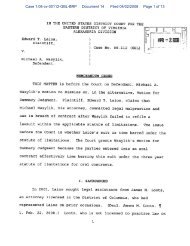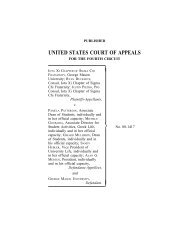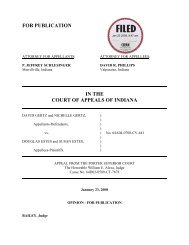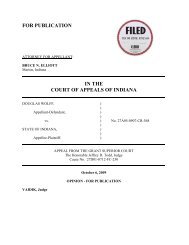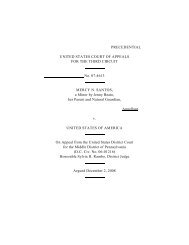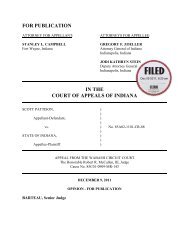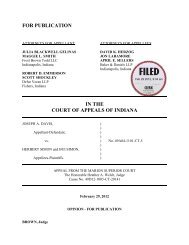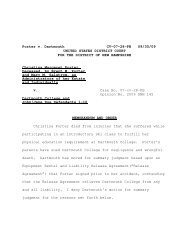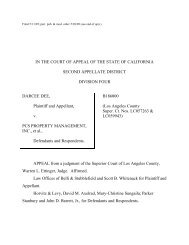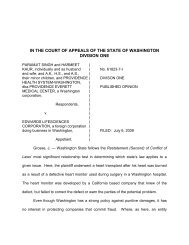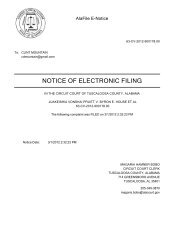SER Kutil v. Blake, Jr., Judge, No. 34618 - Lawyers USA Online
SER Kutil v. Blake, Jr., Judge, No. 34618 - Lawyers USA Online
SER Kutil v. Blake, Jr., Judge, No. 34618 - Lawyers USA Online
Create successful ePaper yourself
Turn your PDF publications into a flip-book with our unique Google optimized e-Paper software.
IN THE SUPREME COURT OF APPEALS OF WEST VIRGINIA<br />
January 2009 Term<br />
__________<br />
__________<br />
__________________________________________________<br />
WRIT GRANTED<br />
__________________________________________________<br />
FILED<br />
June 5, 2009<br />
<strong>No</strong>. <strong>34618</strong> released at 10:00 a.m.<br />
STATE OF WEST VIRGINIA EX REL.<br />
KATHRYN KUTIL AND CHERYL HESS,<br />
Petitioners<br />
v.<br />
RORY L. PERRY II, CLERK<br />
SUPREME COURT OF APPEALS<br />
OF WEST VIRGINIA<br />
HONORABLE PAUL M. BLAKE, JR.,<br />
JUDGE OF THE CIRCUIT COURT OF FAYETTE COUNTY, AND THE<br />
WEST VIRGINIA DEPARTMENT OF HEALTH AND HUMAN RESOURCES,<br />
Respondents<br />
Counsel for Petitioner:<br />
Anthony Ciliberti, <strong>Jr</strong>.<br />
Ciliberti Law Office, PLLC<br />
Fayetteville, West Virginia<br />
Petition for a Writ of Prohibition<br />
Submitted: March 11, 2009<br />
Filed: June 5, 2009
Counsel for the Respondent,<br />
Paul M. <strong>Blake</strong>, <strong>Jr</strong>., <strong>Judge</strong>:<br />
Ancil G. Ramey<br />
Hannah B. Curry<br />
Steptoe & Johnson<br />
Charleston, West Virginia<br />
Counsel for the Respondent,<br />
West Virginia Department of Health and Human Resources:<br />
Darrell V. McGraw, <strong>Jr</strong>.<br />
Attorney General<br />
Charleston, West Virginia<br />
Angela Alexander Ash<br />
Office of the Attorney General<br />
Princeton, West Virginia<br />
Thomas J. Steele, <strong>Jr</strong>.<br />
Fayette County Prosecuting Attorney’s Office<br />
Fayetteville, West Virginia<br />
Guardian Ad Litem:<br />
Thomas K. Fast<br />
Fast Law Office<br />
Fayetteville, West Virginia<br />
Counsel for Amicus Curiae,<br />
National Association of Social Workers<br />
National Association of Social Workers – West Virginia Chapter<br />
The Evan B. Donaldson Adoption Institute<br />
<strong>No</strong>rth American Council on Adoptable Children<br />
West Virginia Coalition Against Domestic Violence:<br />
Robert M. Bastress, <strong>Jr</strong>.<br />
Law Office of Robert M. Bastress, <strong>Jr</strong>.<br />
Morgantown, West Virginia
Allan N. Karlin<br />
Jane E. Peak<br />
Allan N. Karlin & Associates<br />
Morgantown, West Virginia<br />
Maura Monaghan (Admitted Pro Hoc Vice)<br />
Eliza M. Sporn (Admitted Pro Hoc Vice)<br />
Alison J. Page (Admitted Pro Hoc Vice)<br />
Andrea Glen (Admitted Pro Hoc Vice)<br />
Debevoise & Plimpton<br />
New York, New York<br />
Counsel for Amicus Curiae,<br />
ACLU<br />
ACLU of West Virginia<br />
People for American Way Foundation:<br />
Sharon M. McGowan (Admitted Pro Hoc Vice)<br />
ACLU Foundation<br />
Washington, D.C.<br />
Terri S. Bauer<br />
ACLU of West Virginia Foundation<br />
Charleston, West Virginia<br />
Counsel for Amicus Curiae,<br />
Family Policy Council of West Virginia:<br />
James A. Campbell (Admitted Pro Hoc Vice)<br />
Alliance Defense Fund<br />
Scottsdale, Arizona<br />
Jeremiah G. Dys<br />
Family Council of West Virginia<br />
Charleston, West Virginia
Counsel for Amicus Curiae,<br />
Foster Care Alumni Association<br />
CASA of the Eastern Panhandle, Inc.<br />
COLAGE<br />
Fairness West Virginia:<br />
Stephen G. Skinner<br />
Laura C. Davis<br />
Skinner Law Firm<br />
Charles Town, West Virginia<br />
Gregory N. Nevins (Admitted Pro Hoc Vice)<br />
Lambda Legal Defense and Education Fund, Inc.<br />
Atlanta, Georgia<br />
Counsel for Amicus Curiae,<br />
The American College of Pediatricians:<br />
Richard E. Holtzapfel<br />
Holtzapfel Law Offices, PLLC<br />
Hurricane, West Virginia<br />
The Opinion of the Court was delivered PER CURIAM.<br />
JUSTICE WORKMAN concurs and reserves the right to file a concurring opinion.
SYLLABUS BY THE COURT<br />
1. “The writ of prohibition will issue only in clear cases where the inferior<br />
tribunal is proceeding without, or in excess of, jurisdiction.” Syllabus, State ex rel. Vineyard<br />
v. O’Brien, 100 W.Va. 163, 130 S.E. 111 (1925).<br />
2. “In determining whether to entertain and issue the writ of prohibition for<br />
cases not involving an absence of jurisdiction but only where it is claimed that the lower<br />
tribunal exceeded its legitimate powers, this Court will examine five factors: (1) whether the<br />
party seeking the writ has no other adequate means, such as direct appeal, to obtain the<br />
desired relief; (2) whether the petitioner will be damaged or prejudiced in a way that is not<br />
correctable on appeal; (3) whether the lower tribunal’s order is clearly erroneous as a matter<br />
of law; (4) whether the lower tribunal’s order is an oft repeated error or manifests persistent<br />
disregard for either procedural or substantive law; and (5) whether the lower tribunal’s order<br />
raises new and important problems or issues of law of first impression. These factors are<br />
general guidelines that serve as a useful starting point for determining whether a<br />
discretionary writ of prohibition should issue. Although all five factors need not be satisfied,<br />
it is clear that the third factor, the existence of clear error as a matter of law, should be given<br />
substantial weight.” Syl. Pt. 4, State ex rel. Hoover v. Berger, 199 W.Va. 12, 483 S.E.2d 12<br />
(1996).<br />
i
3. “‘Courts are not constituted for the purpose of making advisory decrees or<br />
resolving academic disputes.’ Mainella v. Board of Trustees of Policemen’s Pension or<br />
Relief Fund of City of Fairmont, 126 W.Va. 183, 185-86, 27 S.E.2d 486, 487-88 (1943).”<br />
Syl. Pt. 2, in part, Harshbarger v. Gainer, 184 W.Va. 656, 403 S.E.2d 399 (1991).<br />
4. “The best interests of a child are served by preserving important<br />
relationships in that child’s life.” Syl. pt. 2, State ex rel. Treadway v. McCoy, 189 W.Va.<br />
210, 429 S.E.2d 492 (1993).<br />
5. “A child has a right to continued association with individuals with whom<br />
he has formed a close emotional bond, including foster parents, provided that a<br />
determination is made that such continued contact is in the best interests of the child.” Syl.<br />
Pt. 11, In re Jonathan G., 198 W.Va. 716, 482 S.E.2d 893 (1996).<br />
6. “A statutory provision which is clear and unambiguous and plainly<br />
expresses the legislative intent will not be interpreted by the courts but will be given full<br />
force and effect.” Syl. Pt. 2, State v. Epperly, 135 W.Va. 877, 65 S.E.2d 488 (1951).<br />
ii
Per Curiam:<br />
By means of this original jurisdiction action, Kathryn <strong>Kutil</strong> and Cheryl Hess<br />
(hereinafter collectively referred to as “Petitioners”) seek a writ of prohibition to bar<br />
enforcement of the <strong>No</strong>vember 21, 2008, order 1 of the Circuit Court of Fayette County.<br />
Petitioners specifically are seeking to prevent the female infant, Baby Girl C. (hereinafter<br />
“B.G.C.”), 2 from being removed from their foster home. B.G.C. was placed in Petitioners’<br />
home as a foster child by the West Virginia Department of Health and Human Resources<br />
(hereinafter “DHHR”) 3 shortly after the child’s birth. Petitioners are a same sex couple<br />
whose home had been approved by DHHR for both foster care and adoption. The removal<br />
of the infant was ordered at the conclusion of an abuse and neglect permanency hearing at<br />
which the lower court accepted the recommendation that B.G.C.’s case be transferred to the<br />
adoption unit of DHHR. In its removal order, the lower court directed that B.G.C. be moved<br />
1 As related later in this opinion, the order was orally made at the conclusion<br />
of an evidentiary hearing held on <strong>No</strong>vember 21, 2008, and thereafter incorporated in a<br />
written order dated December 2, 2008.<br />
2 Following our traditional practice in child abuse and neglect matters and other<br />
cases involving sensitive facts, we will not reveal the child’s last name. See, e.g., In Interest<br />
of Tiffany Marie S., 196 W.Va. 223, 226 n. 1, 470 S.E.2d 177, 180 n. 1 (1996).<br />
3 Both <strong>Judge</strong> Paul M. <strong>Blake</strong> (hereinafter “Respondent”) and DHHR are named<br />
as respondents in the petition before us; however, prohibition does not lie against DHHR<br />
under the facts of this case because the agency was not acting in a judicial capacity. See<br />
W.Va. Code § 53-1-1 (1923) (Repl. Vol. 2008); State ex rel. Miller v. Smith, 168 W.Va. 745,<br />
756, 285 S.E.2d 500, 506 (1981) (performance of executive duties is not subject to a writ of<br />
prohibition).<br />
1
from her temporary foster home and placed in a household interested in adoption that is a<br />
“traditional family” having a mother and a father rather than a household headed by a same<br />
sex couple or single person. In consideration of the arguments of the parties, 4 copies of court<br />
documents supplied with the briefs as exhibits and applicable legal authorities, we grant the<br />
relief requested.<br />
I. Factual and Procedural Background 5<br />
When B.G.C. was born on December 8, 2007, she tested positive for the<br />
presence of cocaine and oxycodone in her bloodstream. On this basis, while B.G.C. was still<br />
in the hospital DHHR instituted abuse and neglect proceedings against the biological<br />
4 We hereby acknowledge the contribution of the various amici curiae who filed<br />
briefs in this case. We have received three amicus briefs supporting Petitioners’ position:<br />
one jointly authored by the American Civil Liberties Union, American Civil Liberties Union<br />
of West Virginia and People for the American Way Foundation; a second representing the<br />
collaborative efforts of Foster Care Alumni of America, COLAGE, CASA (Court Appointed<br />
Special Advocates) of the Eastern Panhandle, Inc. and Fairness West Virginia; and the third<br />
presented by the National Association of Social Workers, National Association of Social<br />
Workers – West Virginia Chapter, Evan B. Donaldson Adoption Institute, <strong>No</strong>rth American<br />
Council on Adoptable Children, and West Virginia Coalition Against Domestic Violence.<br />
Two amicus briefs were filed in support of Respondents’ position: one by The American<br />
College of Pediatricians and the other by The Family Policy Council of West Virginia. We<br />
value the participation of these groups and the insights their briefs lend to the parties’<br />
arguments.<br />
5 To aid the reader in understanding the numerous facts of this case, a timeline<br />
of significant occurrences is supplied as an appendix to this opinion.<br />
2
mother, 6 and was granted custody of B.G.C. on December 13, 2007. At the same time, the<br />
court appointed a guardian ad litem (hereinafter “GAL”) for B.G.C. Upon discharge of the<br />
infant from the hospital on December 24, 2007, DHHR placed B.G.C. directly into<br />
Petitioners’ home, which had been approved previously by DHHR for both foster parenting<br />
and adoption and was then serving as a foster home for several other children. 7<br />
A motion to remove B.G.C. from the foster home was filed by the infant’s<br />
GAL on January 24, 2008. 8 In support of his motion, the GAL maintained that removal was<br />
necessary even though the home appears “to be comfortable and physically safe for the<br />
infant respondent . . . [he nonetheless believed] that the best interest of the child is not to be<br />
raised, short term or long term, in a homosexual environment and that the same is<br />
detrimental to the child’s overall welfare and well-being.” DHHR and the foster parents<br />
filed responses objecting to the motion. The motion was entertained at a January 31, 2008,<br />
hearing at which the lower court granted intervenor status to Petitioners. The February 25,<br />
2008, order issued as a result of this hearing reflects that the court determined “not [to]<br />
6 The identity of the biological father is unknown.<br />
7 Ms. <strong>Kutil</strong>’s adopted daughter, who had initially been placed by DHHR in the<br />
home as a foster child, was among the children present when B.G.C. was placed in the foster<br />
home. It is noteworthy that the adoption, which also occurred in Fayette County, was<br />
approved by the other judge in the circuit.<br />
8 The motion also asked the court to enter a statewide injunction against DHHR<br />
to prohibit the agency “from placing foster children in homosexual homes,” for which the<br />
lower court ultimately determined it lacked jurisdiction.<br />
3
interfere with the current foster care placement at this time” and reserved ruling on the<br />
removal motion as well as the GAL’s request for full hearing on the motion.<br />
The child’s biological mother was granted two improvement periods, however,<br />
she failed in her efforts to become a fit parent. The biological mother’s parental rights were<br />
terminated at a dispositional hearing held on October 8, 2008, which termination is<br />
memorialized in a <strong>No</strong>vember 5, 2008, order. Shortly following the termination, a<br />
multidisciplinary treatment team (hereinafter “MDT”) met to discuss B.G.C.’s future. A<br />
“MDT/Status Report” dated October 28, 2008, containing the results of this meeting was<br />
submitted to the court. The report reflected that the MDT endorsed the transfer of B.G.C.’s<br />
case to DHHR’s regional adoption unit and recommended that B.G.C. remain in Petitioners’<br />
home during the adoption process. The MDT report also related that the team had been<br />
informed by the adoption unit supervisor that “there would be no reason for the Adoption<br />
Unit to move . . . [B.G.C.] due to family members and siblings being previously ruled out [9]<br />
. . . . [and that] the Adoption Unit would be reluctant to ‘uproot’ a child from the only home<br />
she knows.” The only member of the MDT who objected to the recommendation was the<br />
GAL. Following the release of the MDT report, DHHR issued a permanency plan on<br />
9 In response to an order of the lower court, DHHR had conducted home studies<br />
to determine if a custodial arrangement with a family member or sibling was feasible. These<br />
efforts resulted in finding that no such acceptable placement existed for B.G.C.<br />
4
October 31, 2008, indicating the department’s position that adoption was in the best interest<br />
of B.G.C.<br />
The permanency plan also noted that Petitioners had expressed the desire to<br />
adopt B.G.C. followed by a list of reasons why the home would be appropriate for adoption.<br />
A permanency hearing in the abuse and neglect case was held on <strong>No</strong>vember<br />
6, 2008, at which the GAL renewed his motion for removal of B.G.C. from a “homosexual<br />
home.” The lower court set forth its findings from the initial permanency hearing in a<br />
<strong>No</strong>vember 12, 2008 order. The order begins with a summary of the positions of the parties<br />
and then states the observations and findings of the lower court, including the following:<br />
29. It also appears to the Court that the fairness showed by<br />
the Court by allowing the child to remain with the foster parents<br />
pending resolution of the case is now being used to support the<br />
argument that, since the child is developing bonds with the<br />
intervenors, the child should not be removed from the<br />
intervenors’ care, and that adoption by the intervenors should be<br />
recommended without purs[ue]ing adoptive parents which could<br />
provide a more traditional home setting.<br />
* * * * *<br />
31. The Court FINDS that children need both mother and<br />
father and that avenues to such a result should at the least be<br />
explored by the DHHR. The Court FINDS that untraditional<br />
family settings should not be the first and only route taken by<br />
the DHHR when searching for a permanent/adoptive placement<br />
for a child.<br />
5
The <strong>No</strong>vember 12 order also includes the following conclusions of law:<br />
4. The Court CONCLUDES that Circuit Courts are not<br />
required to accept the Permanency Plan of the DHHR and may<br />
either accept, reject or modify said recommendation depending<br />
on whether or not the Court finds it to be in the best interests of<br />
the child at issue.<br />
5. The Court CONCLUDES that the polar star in all<br />
matters involving children is what is in the best interest of the<br />
child.<br />
* * * * *<br />
7. The Court CONCLUDES that the standards and<br />
guidelines in the Rules applicable for permanency placement<br />
review hearings are also applicable and should be considered<br />
during the initial permanency plan hearings. Pursuant to these<br />
standards and guidelines imposed upon the Courts, the Court<br />
must consider, among other things, the appropriateness of the<br />
current placement of the child and whether it is the most familylike<br />
setting. See Rule 41(a)(6). 10<br />
10 Although not squarely before us, an argument raised in the amicus brief<br />
jointly submitted by the American Civil Liberties Union, the American Civil Liberties Union<br />
of West Virginia and the People for the American Way Foundation maintains that the lower<br />
court incorrectly relied upon the parenthetical reference to “most family-like” placement in<br />
Rule 41(a)(6) to arrive at the conclusion that a traditional home consisting of a mother and<br />
father is a preferred foster placement or adoptive home in this state. The first point argued<br />
in the brief is that the Abuse and Neglect Rules do not govern adoption proceedings and<br />
cannot be used to support the concept that the law favors adoption by married couples. It<br />
is then proposed that the provision in Rule 41(a)(6) of the Rules of Procedure for Abuse and<br />
Neglect Proceedings (hereinafter “Abuse and Neglect Rules”) requiring consideration of<br />
whether a foster home placement of an abused and neglected child is “the least restrictive<br />
one (most family-like one) available,” simply indicates a preference for a foster home over<br />
a group home or institutional setting. As further support for this position, reference is made<br />
to the following related Abuse and Neglect Rule provisions: Rule 41(a)(10)(E) (“If<br />
placement in a group home or institution is recommended [matters for discussion at a<br />
permanent placement review conference should include]: (i) An explanation of why<br />
(continued...)<br />
6
8. The Court CONCLUDES that, if at all possible, it is in<br />
the best interest of children to be raised by a traditionally<br />
defined family, that is, a family consisting of both a mother and<br />
a father. The Court CONCLUDES that non-traditional<br />
families, such as the intervenors, should only be considered as<br />
appropriate permanent/adoptive placements if the DHHR first<br />
makes a sufficient effort to place the child in a traditional home<br />
and those efforts fail. In other words, if the DHHR has<br />
attempted in good faith to secure a traditional family to adopt<br />
the child and the DHHR’s attempts fail, then a non-traditional<br />
family may be considered as an adoptive placement. This did<br />
not occur in the present case.<br />
9. For the above stated reasons, the Court CONCLUDES<br />
that it can only tentatively approve the Permanency Plan<br />
pending argument/hearing to address the issues raised in this<br />
hearing regarding the Permanency Plan, including the extent of<br />
the Court’s authority over the execution of the Permanency<br />
Plan . . . and argument/evidence in support of and in opposition<br />
to the guardian ad litem’s pending motions.<br />
10. The Court CONCLUDES it is necessary and in the best<br />
interest of the child to ORDER that the DHHR place the child<br />
in a traditional home setting with a mother and a father. The<br />
Court deems such action necessary to materially promote the<br />
best interests of the child. In recognition of the bonds that may<br />
have formed between the child and the intervenors, and to<br />
lessen any stress on the child, the Court CONCLUDES that it<br />
is in the best interests of the infant child that the removal from<br />
the intervenors’ home and placement in a traditional home<br />
10 (...continued)<br />
treatment outside a family environment is necessary, including a brief summary of<br />
supporting expert diagnoses and recommendations; and (ii) A discussion of why a less<br />
restrictive, more family-like setting is not practical, including placement with specially<br />
trained foster parents[.]”); and Rule 28(c)(3) (The contents of a child’s case plan when<br />
DHHR’s recommendation is temporary or permanent placement outside of the child’s home<br />
must include “[a] description of the recommended placement or type of home or institutional<br />
placement in which the child is to be placed . . . and whether or not it is the least restrictive<br />
(most family-like) one available.”<br />
7
should be completed over a two week transitional period. The<br />
purpose of the removal and transfer to a traditional home<br />
is to materially promote the best interests of the child by<br />
encouraging and facilitating adoptive placement of the child<br />
with a traditionally defined family and to ease the child’s<br />
transition when and if such adoptive placement occurs.<br />
(Emphasis in original.) The order also set <strong>No</strong>vember 21, 2008, as the date on which the<br />
evidentiary hearing regarding the permanency plan would be held.<br />
On <strong>No</strong>vember 17, 2008, Petitioners petitioned this Court for a writ of<br />
prohibition accompanied by a motion for an emergency stay of the lower court’s order of<br />
removal. The lower court rendered both matters moot by entering an order on <strong>No</strong>vember<br />
18, 2008, staying its removal order.<br />
DHHR had objected to the removal of B.G.C. from Petitioner’s home until<br />
the day of the <strong>No</strong>vember 21, 2008, evidentiary hearing. Prior to the hearing convening that<br />
day, DHHR informed the lower court by fax that B.G.C. needed to be moved to another<br />
foster care home because Petitioners’ home was over the capacity limit set for foster<br />
homes. 11 At the hearing it was made known that the last foster placement by DHHR in<br />
11 There were a total of seven children in Petitioners’ home on the day of the<br />
<strong>No</strong>vember 21 hearing, six foster children and Ms. <strong>Kutil</strong>’s adopted daughter. The maximum<br />
number of children a foster home may house at one time is not entirely clear. West Virginia<br />
Code § 49-2B-2 (p) (2006) (Supp. 2008) sets the capacity at “no more than five children who<br />
are unrelated by blood, marriage or adoption to any adult member of the household.”<br />
However, there are inconsistencies in the state regulations regarding occupancy limits of<br />
(continued...)<br />
8
Petitioners’ home had occurred on October 31, 2008, shortly before either of the permanency<br />
plan hearings.<br />
The evidence presented at the <strong>No</strong>vember 21, 2008, hearing included the<br />
testimony of DHHR adoption and child protective service workers, both Petitioners and two<br />
expert witnesses – a clinical psychologist called by the GAL, and a clinical/forensic<br />
psychiatrist called by Petitioners. 12 At the conclusion of the hearing, the lower court<br />
renewed its previous finding that adoption was the proper permanency plan for B.G.C. and<br />
ordered from the bench that B.G.C. be removed from Petitioners’ home by noon the<br />
following day for placement in the home of a married couple DHHR had identified as a<br />
potential adoptive home. The lower court later summarized the basis for its action in a<br />
December 2, 2008, order. This order included the following relevant findings of fact and<br />
conclusions of law:<br />
13. The Court FINDS that the <strong>Kutil</strong>-Hess household may be<br />
the most appropriate adoptive placement home for the child, but<br />
it is unfair not to allow the child the option to be adopted by a<br />
traditional family. The child should be given the opportunity to<br />
be adopted by mother-father adoption and not be locked into a<br />
single parent adoption.<br />
11 (...continued)<br />
foster care homes. See 78 C.S.R. 2-3.18 (providing that a foster family home may care for<br />
five or less children), contra 78 W.Va. C.S.R. § 2-13.3.a. (providing that the number of<br />
children who may reside in a foster home “may not exceed six (6).”).<br />
12 According to their testimony, neither of the experts actually assessed<br />
B.G.C.’s foster home relationships or environment.<br />
9
(Emphasis in original).<br />
* * * * *<br />
15. The Court FINDS that the Permanency Plan of transition<br />
to the DHHR Adoption Unit is appropriate and should be<br />
accepted by this Court.<br />
16. The Court FINDS that [B.G.C.] is presently in the<br />
intervenors’ home, however, the DHHR has found the<br />
intervenors’ home is over capacity and has asked the Court to<br />
remove the child with a transitional period, based upon that<br />
reason. Thus, the Court FINDS that [B.G.C.] should be moved<br />
immediately. The Court FINDS that placement of [B.G.C.] in<br />
a home with a married mother and father pending such adoption<br />
process is most appropriate for the child’s well being.<br />
CONCLUSIONS OF LAW<br />
1. The Court CONCLUDES that the intervenors can not<br />
adopt this child as a couple because of statute. The intervenors<br />
argue that they are the only proper parties to be considered for<br />
the adoption of [B.G.C.]; however, under West Virginia law<br />
§48-22-201, only married couples, married persons with consent<br />
of their spouse, or single persons may petition to adopt a child.<br />
For this reason, the Court CONCLUDES that the intervenors<br />
cannot lawfully petition together to adopt B.G.C., only one of<br />
the two intervenors may petition for adoption.<br />
2. The Court CONCLUDES that the DHHR’s request for<br />
removal based upon the fact that the intervenors’ home is<br />
overcapacity should be GRANTED as it is in the child’s best<br />
interest. Further considering the well-being of the child, the<br />
Court CONCLUDES and ORDERS that the child be removed<br />
from the intervenors’ home by 12:00 noon <strong>No</strong>vember 22, 2008.<br />
Before the written order was issued, Petitioners acted on the pronouncement<br />
of the lower court at the <strong>No</strong>vember 21 hearing by again seeking an emergency stay by this<br />
10
Court of the removal order. We granted the stay requested on <strong>No</strong>vember 26, 2008. 13<br />
Thereafter, on December 9, 2008, this Court granted Petitioners leave to amend their<br />
previously filed petition for a writ of prohibition which is now under consideration.<br />
II. Standard of Review<br />
The original jurisdiction authority of this Court to consider matters of<br />
prohibition stems from Article VIII, § 3 of the West Virginia Constitution. That authority<br />
is further recognized and defined by statute and rule. See W.Va. Code §§ 51-1-3 (1923); 53-<br />
1-2 (1933); W.Va. R. App. P. 14. Historically, we have been guarded about granting relief<br />
in prohibition, reserving its use for extraordinary situations. As we stated in the syllabus of<br />
State ex rel. Vineyard v. O’Brien, 100 W.Va. 163, 130 S.E. 111 (1925), “[t]he writ of<br />
prohibition will issue only in clear cases where the inferior tribunal is proceeding without,<br />
or in excess of, jurisdiction.”<br />
Petitioners do not allege that the lower court acted without jurisdiction of the<br />
subject matter and parties in the abuse and neglect action, but instead maintain that the lower<br />
13 Although Petitioners took steps to stop the enforcement of the removal order,<br />
it is undisputed that Petitioners complied with the terms of the order and delivered B.G.C.<br />
with her belongings to her new foster home on <strong>No</strong>vember 22. As related to this Court, on<br />
or about <strong>No</strong>vember 26, 2008, the prospective adoptive parents named in the removal order<br />
informed DHHR that conditions had changed and they were no longer in a position to adopt<br />
B.G.C.. The child was returned to Petitioners’ home later this same day after this Court<br />
granted Petitioners’ motion for the emergency stay of the removal order.<br />
11
court went beyond the bounds of its authority in ordering removal in this case. In such<br />
circumstances, we consider those measures outlined in syllabus point four of State ex rel.<br />
Hoover v. Berger, 199 W.Va. 12, 483 S.E.2d 12 (1996), which reads as follows:<br />
In determining whether to entertain and issue the writ of<br />
prohibition for cases not involving an absence of jurisdiction but<br />
only where it is claimed that the lower tribunal exceeded its<br />
legitimate powers, this Court will examine five factors: (1)<br />
whether the party seeking the writ has no other adequate means,<br />
such as direct appeal, to obtain the desired relief; (2) whether the<br />
petitioner will be damaged or prejudiced in a way that is not<br />
correctable on appeal; (3) whether the lower tribunal’s order is<br />
clearly erroneous as a matter of law; (4) whether the lower<br />
tribunal’s order is an oft repeated error or manifests persistent<br />
disregard for either procedural or substantive law; and (5)<br />
whether the lower tribunal’s order raises new and important<br />
problems or issues of law of first impression. These factors are<br />
general guidelines that serve as a useful starting point for<br />
determining whether a discretionary writ of prohibition should<br />
issue. Although all five factors need not be satisfied, it is clear<br />
that the third factor, the existence of clear error as a matter of<br />
law, should be given substantial weight.<br />
With this standard in mind, we proceed to consider whether it was proper for<br />
the lower court to order removal of the infant from Petitioners’ home.<br />
III. Discussion<br />
Petitioners assert that the lower court was exceeding its legitimate authority<br />
by ordering the removal of B.G.C. from their home for placement in a traditional home<br />
which the court defined as headed by a mother and a father. Respondent asserts that removal<br />
was legally required under the circumstances before it because: (1) Petitioners as a couple<br />
12
are not permitted to adopt a child under the provisions of the adoption statute, and (2) the<br />
number of children residing in Petitioners’ foster home exceeded the statutory limit. It is<br />
upon these legal foundations that Respondent maintains that it was necessary to order<br />
removal of the child from the home. Respondent further contends it also was appropriate<br />
to order placement of B.G.C. with a suitable married couple interested in adoption given the<br />
legislative preference expressed in the adoption statutes for adoption by married couples.<br />
A. Removal<br />
As to Respondent’s first ground for removal, it is not at all clear that the issue<br />
of joint adoption by unmarried parties was before the court. It is important to keep in mind<br />
that the purpose of the permanency hearing in an abuse and neglect case is to determine what<br />
type of permanent placement would provide “the level of custody, care, commitment,<br />
nurturing and discipline that is consistent with . . . [a] child’s best interests.” State v.<br />
Michael M., 202 W.Va. 350, 358, 504 S.E.2d 177, 185 (1998). And although adoption is<br />
the preferred permanent placement for a child when parental rights are terminated, 14 it is but<br />
one permanent placement option which DHHR may recommend in its permanency plan. 15<br />
14 Syl. Pt. 2, State v. Michael M., supra.<br />
15 See W.Va. Code § 49-6-5a (2007) (Supp. 2008); R. 41, W. Va. Rules of<br />
Procedure for Child Abuse and Neglect (identifying possible permanent living arrangements<br />
which may be recommended in abuse and neglect cases as returning a child to parent(s),<br />
adoption, placement of a child with fit and a willing relative, a legal guardian or in another<br />
planned permanent arrangement, including institutional settings).<br />
13
It was made abundantly clear during the course of the hearings in the present case that the<br />
permanency plan is designed to recommend a general course of action regarding future<br />
placement of a child after parental rights have been terminated, and that it would be<br />
premature for DHHR to recommend a particular adoptive home at the permanency hearing.<br />
Certainly, DHHR has the responsibility to develop a permanent placement plan for a child<br />
contemporaneously with reunification efforts, 16 but the details of the plan necessarily depend<br />
on the course of action the court determines to be most suitable under the circumstances.<br />
According to the testimony of DHHR workers, a particularized plan for a child whose<br />
recommended permanent placement is an adoptive home would not be completed until after<br />
the child’s case is transferred to DHHR’s adoption unit because the agency’s operations<br />
involving adoptive home selection are run separately from DHHR’s operations involving<br />
services for abuse and neglect victims. We further note that although Petitioners may have<br />
indicated the desire to make B.G.C. a permanent part of their household, there was no formal<br />
joint or individual request for adoption pending before the court at the permanency hearings.<br />
This Court has clearly and consistently maintained that “‘[c]ourts are not<br />
constituted for the purpose of making advisory decrees or resolving academic disputes.’<br />
Mainella v. Board of Trustees of Policemen’s Pension or Relief Fund of City of Fairmont,<br />
126 W.Va. 183, 185-86, 27 S.E.2d 486, 487-88 (1943).” Syl. Pt. 2, in part, Harshbarger<br />
16 Syl. Pt. 5, In re Billy Joe M., 206 W.Va. 1, 521 S.E.2d 173 (1999).<br />
14
v. Gainer, 184 W.Va. 656, 403 S.E.2d 399 (1991). It was thus inappropriate for the lower<br />
court to rule as a matter of law on the subject of the propriety of joint adoption of a child by<br />
a same sex couple because it was not a matter pending before the court. Moreover,<br />
Petitioners have represented to this Court that joint adoption is not being sought, and Ms.<br />
<strong>Kutil</strong> has informed DHHR of her interest in adopting B.G.C. as a single person.<br />
We next consider whether overcapacity suffices as a ground for removal of<br />
B.G.C. from her home. As was noted earlier, there were seven children residing in<br />
Petitioners’ foster home during the time period when both permanency hearings occurred.<br />
Whether the upper limit for the number of children who may reside in a foster home is five<br />
or six, 17 Petitioners’ foster home was overcapacity and the situation needed to be corrected. 18<br />
Our concern lies with the manner in which the problem was rectified.<br />
In its response to the pending writ of prohibition, DHHR stated that the change<br />
in the agency’s position regarding removal of B.G.C. only occurred because of<br />
“overcrowding at Petitioners’ home and the ready availability of a foster home that was<br />
17 See supra n. 7.<br />
18 We find it disconcerting that DHHR just “discovered” the overcapacity issue<br />
on the date of the hearing when the agency had created the situation by placing what appears<br />
to have been more than one child in the home a month earlier. Even accepting DHHR’s<br />
representation that the worker who handled the last placement in the home misunderstood<br />
relevant procedures, it is certainly not clear why it took a month for the agency to uncover<br />
this problem.<br />
15
willing and capable at the time to accept the infant, . . . . [and the agency] did not at that time<br />
have a placement available for the children who were most recently placed in the Petitioners’<br />
home.” DHHR then added, “<strong>No</strong>where has WVDHHR indicated that the home provided by<br />
Petitioners was anything other than loving and nurturing.” Despite the number of times that<br />
this Court has stated the best interest of the child is the polar star upon which decisions<br />
involving children are to be based, 19 DHHR did not even consider whether the individual<br />
needs of B.G.C. would be best served by removing her from Petitioners’ care, but instead<br />
opted for a swift and ready solution to the problem the agency created. The agency simply<br />
turned a blind eye to the fact that B.G.C. had been placed in the foster home a number of<br />
months before some of the other children then in the home, and ignored any consideration<br />
of the impact relocation would have on B.G.C.’s emotional, physical and mental<br />
development. By following the lead of DHHR, the lower court erred in not closely<br />
examining the individual needs of B.G.C. as well as of the other children placed in<br />
Petitioners’ home to determine how the best interests of all the children would be served<br />
while remedying the overcapacity problem of the foster home.<br />
<strong>No</strong> evidence was produced at the hearings as to Petitioners providing anything<br />
but quality care in their foster home, or of any particular problems B.G.C. was experiencing<br />
in her foster home environment. Consequently, the main concern in solving the<br />
19<br />
See In re Erica C., 214 W.Va. 375, 380, 589 S.E.2d 517, 522 (2003)<br />
(numerous cases listed).<br />
16
overcrowding problem should have been what affect the disruption of relocation would have<br />
on the emotional and physical well-being of the individual children in the home. The length<br />
of time each of the foster children was in the home no doubt would affect the strength of the<br />
emotional bond that had developed between each child and Petitioners as well as their sense<br />
of comfort and security with their home environment. The only home B.G.C. had ever<br />
known in the eleven months of her life had been Petitioners’ foster home. Surely bonding<br />
had occurred between the infant and Petitioners to a much larger extent than with children<br />
who had lived in the household for a much shorter period of time. We have been clear in<br />
pointing out that “[t]he best interests of a child are served by preserving important<br />
relationships in that child’s life.” Syl. pt. 2, State ex rel. Treadway v. McCoy, 189 W.Va.<br />
210, 429 S.E.2d 492 (1993). This concern extends to the relationship a child in foster care<br />
has with foster parents. As we held in syllabus point eleven of In re Jonathan G., 198 W.Va.<br />
716, 482 S.E.2d 893 (1996), “[a] child has a right to continued association with individuals<br />
with whom he has formed a close emotional bond, including foster parents, provided that a<br />
determination is made that such continued contact is in the best interests of the child.” Cf.<br />
In re Clifford K., 217 W.Va. 625, 619 S.E.2d 138 (2005) (recognizing that a foster parent<br />
may attain the status of psychological parent when the relationship is not temporary in<br />
duration and exists with the consent and encouragement of a child’s legal parent or<br />
guardian). The GAL contends that because B.G.C. is a child under the age of two she is less<br />
apt to have bonded with her foster parents. He relies on language we quoted from a<br />
17
Pennsylvania Superior Court in our decision in West Virginia Department of Human<br />
Services v. La Rea Ann C.L., 175 W.Va. 330, 332 S.E.2d 632 (1985) to support this<br />
proposition. This reliance is misplaced. The fundamental issue decided in La Rea Ann C.L.<br />
is that a minor parent’s right to revoke the relinquishment of child custody ceases to be<br />
absolute when an unreasonable period of time has passed. Id. at Syl. Pt. 2. We further<br />
determined that in such circumstances “the best interests of the child not only be considered<br />
but be given primary importance.” Id. The case was then remanded with instruction to the<br />
trial court “to receive evidence to make a finding of fact on the child’s best interests<br />
presently.” Id. at 337, 332 S.E.2d at 638. Thus, whether a given child has bonded with a<br />
parental figure is a question of fact.<br />
The situation before us involves a removal decision where the foster home<br />
environment or care provided in a foster home is not in question, and removal of a child is<br />
necessary to correct problems created by bureaucratic error. When presented with such<br />
situations, courts need to safeguard the best interests of the children by examining evidence<br />
of the emotional, physical and mental needs of the individual children under the particular<br />
circumstances of a case, and then balancing the relative interests of the children in order to<br />
decide which child or children would be less traumatized or detrimentally affected by being<br />
removed from the home. <strong>No</strong> such examination or balancing occurred in the present case.<br />
However, even though the relevant analysis regarding the best interests of the children<br />
18
placed in Petitioners’ home is a significant oversight, it is unnecessary for the lower court<br />
to further address that issue as we have been informed that the overcrowding problem has<br />
been resolved. During oral argument in this case, the Court was told that the foster home is<br />
no longer overcapacity, with only five children, including B.G.C., presently residing in<br />
Petitioners’ home. Consequently, removal of B.G.C. to resolve an overcrowding problem<br />
is moot.<br />
In consideration of the foregoing discussion of the grounds upon which<br />
Respondent ordered removal of B.G.C., such action constituted clear error and the writ of<br />
prohibition is granted on the removal issue.<br />
B. Adoption<br />
Finding no merit in the grounds for removal asserted by Respondent, we must<br />
also consider Respondent’s contention that removal of B.G.C. to a foster home representing<br />
a more traditional family unit consisting of a married mother and father who are interested<br />
in adoption furthers a legislative preference expressed in the adoption statutes.<br />
West Virginia Code § 48-22-201 (2001) (Repl. Vol. 2004) provides that<br />
[a]ny person not married or any person, with his or<br />
spouse’s consent, or any husband and wife jointly, may petition<br />
a circuit court of the county wherein such person or persons<br />
19
eside for a decree of adoption of any minor child or person who<br />
may be adopted by the petitioner or petitioners.<br />
The statute thus sets forth three classifications of persons who may adopt: (1) an unmarried<br />
person; (2) a married couple jointly, and (3) an individual in a marriage whose spouse<br />
consents. Although Respondent recognized that each Petitioner may individually petition<br />
to adopt under the statute, he asserts in his brief that the “statutes indicate a preference for<br />
adoption by married couples.” <strong>No</strong> statutory citation was supplied to support this position<br />
and our research reveals no such stated preference. <strong>No</strong>r were we able to locate any<br />
legislatively assigned preference for adoption into a traditional home or any statutory<br />
definition of a traditional home for adoption purposes. As is evident from the clear language<br />
of West Virginia Code § 48-22-201, there is no prioritization among the three classifications<br />
of those eligible to adopt a child in this state. “A statutory provision which is clear and<br />
unambiguous and plainly expresses the legislative intent will not be interpreted by the courts<br />
but will be given full force and effect.” Syl. Pt. 2, State v. Epperly, 135 W.Va. 877, 65<br />
S.E.2d 488 (1951). 20<br />
20 The only express legislative preferences we have found with particular regard<br />
to adoption of children in the legal custody of the State involve grandparents and<br />
reunification of siblings. Specifically, West Virginia Code § 49-3-1 (a)(3) establishes that<br />
a grandparent or grandparents found to be both suitable and willing to adopt a child in<br />
DHHR’s custody be given priority over other prospective adoptive parents, and West<br />
Virginia Code § 49-2-14 (e) & (f) expresses the preference that DHHR reunite siblings for<br />
either foster care or adoption purposes if such arrangement is available and is determined to<br />
be in the best interests of the children. Neither of these preferences are automatic, however,<br />
as they turn on the best interests of the child who is the candidate for adoption.<br />
20
<strong>No</strong>twithstanding Respondent’s and GAL’s suggestions to the contrary, there<br />
simply is no legislative differentiation between categories of eligible candidates for adoption<br />
under the terms of West Virginia Code § 48-22-201. Such policy determination is clearly<br />
a legislative prerogative, outside of the purview of the courts. The primary concern of courts<br />
in adoption cases is whether there is evidence that the recommended adoptive home<br />
possesses the necessary attributes to meet the individual and specific needs of the child both<br />
at present and in the future. 21<br />
C. Summary<br />
Central to our deliberation in this case is the reason or motivation underlying<br />
Respondent’s decision to remove a child from her foster care home. The motion to remove<br />
the child was not supported by any allegation that B.G.C. was receiving improper or unwise<br />
care and management in her foster home, or that she was being subjected to any other legally<br />
recognized undesirable condition or influence. W.Va. Code § 49-2-12 (1970) (Repl. Vol.<br />
2004); see also W.Va. Code § 49-2-14 (2002) (Repl. Vol. 2004) (criteria and procedure for<br />
removal of child from foster home). Likewise, no evidence supporting a legal reason for<br />
removing the child was presented at the hearings. As a matter of fact, the court was never<br />
presented with any actual evaluation of the home or evidence of the quality of the<br />
21 Our discussion in this case does not extend to equal protection considerations<br />
because Petitioners did not raise that argument during the course of the proceedings below<br />
nor did they pursue it once raised in this prohibition proceeding.<br />
21
elationship B.G.C. had with Petitioners. Moreover, Respondent deferred hearing testimony<br />
from Petitioners’ witnesses regarding their parenting abilities. Nevertheless, there also was<br />
no indication that Petitioners provided B.G.C. with anything other than a loving and<br />
nurturing home. As Respondent observed from the bench at the <strong>No</strong>vember 21 hearing,<br />
“there has been absolutely no allegation that these women have not cared for [B.G.C.] or the<br />
other kids and, in fact, all of the evidence indicates that they have done very well and have<br />
provided very well for the children.” Without any information that the foster care placement<br />
with Petitioners was not proceeding well, there was no legal reason for the court to remove<br />
B.G.C. from the only home she has known.<br />
It is more than apparent that the only reason why Petitioners were being<br />
replaced as foster care providers was to promote the adoption of B.G.C. by what Respondent<br />
called in his <strong>No</strong>vember 12, 2008, order a “traditionally defined family, that is, a family<br />
consisting of both a mother and a father.” It was only by addressing issues he anticipated<br />
would develop and believed would be problems at a later point in this case that Respondent<br />
was even able to reach the subject of this conclusion. The conclusion itself thus represents<br />
a blurring of legal principles applicable to abuse and neglect and adoption. Moreover, even<br />
if our current statutes, rules and regulations could somehow be read to support the adoption<br />
preference proposed by Respondent, such a newfound principle would need to be<br />
harmonized with established law. Under our current law which encourages adoption by<br />
22
qualified foster parents, one of the Petitioners seeking to adopt B.G.C. individually would<br />
at the very least need to be considered if not favored in the selection of the prospective<br />
adoptive home. 22<br />
In the present case, all indications thus far are that B.G.C. has formed a close<br />
emotional bond and nurturing relationship with her foster parents, which can not be<br />
trivialized or ignored. State ex rel. Treadway v. McCoy; In re Jonathan G. As such, it<br />
serves as a classic example of a case in which the permanency plan for adoption should<br />
move quickly to the desired result of a permanent home for B.G.C. One of the Petitioners<br />
who has already adopted a child 23 and appreciates the tremendous responsibility adoption<br />
entails, has recently expressed the desire to adopt B.G.C. Clearly, that Petitioner should not<br />
be excluded from consideration for the reason stated by Respondent. These factors all<br />
should serve to facilitate the selection process, which needs to be completed as expeditiously<br />
as possible in order to further the best interests of B.G.C. and in recognition and support of<br />
the parenting investment which has been made.<br />
IV. Conclusion<br />
22 See State ex rel. Treadway v. McCoy, 189 W.Va. at 213, 429 S.E.2d at 495;<br />
cf. In re Jonathan G., 198 W.Va. at 735, 482 S.E.2d at 913.<br />
23 See supra n. 6.<br />
23
Petitioners is granted.<br />
For the reasons stated in this opinion, the writ of prohibition sought by<br />
24<br />
Writ of prohibition granted.
APPENDIX<br />
TIMELINE OF SIGNIFICANT OCCURRENCES<br />
12-8-07 B.G.C. born testing positive for cocaine & oxycodone.<br />
12-11-07 Abuse & neglect [A&N] petition filed.<br />
12-13-07 DHHR granted legal custody of B.G.C.; GAL appointed for B.G.C.<br />
12-24-07 B.G.C. placed in foster home of Petitioners after discharge from hospital.<br />
1-24-08 GAL filed a “Motion to Order DHHR to Remove Child from Physical<br />
Placement in Homosexual Home & Other Injunctive Relief.”<br />
10-28-08 MDT meeting held and report issued finding adoption of the child as the<br />
acceptable disposition; report reflects DHHR Adoption Supervisor “informed<br />
MDT members that, although she must ‘ensure that [B.G.C.] is doing well in<br />
her present placement”, there would be no reason for the Adoption Unit to<br />
move her due to family members and siblings being previously ruled out.”<br />
The report goes on to say that the supervisor “further stated that the Adoption<br />
Unit would be reluctant to ‘uproot’ a child from the only home she knows.”<br />
10-31-08 Date on which DHHR placed seventh child in Petitioner’s home [a foster<br />
home’s maximum capacity is set at 5 or 6 foster children].<br />
11-5-08 Order terminating parental rights of B.G.C.’s mother; the parental rights of<br />
both the mother and unknown father were terminated at a dispositional hearing<br />
held on October 8, 2008.<br />
11-6-08 Permanency hearing in A&N case [DHHR recommends adoption].<br />
11-12-08 First order of removal entered [directing that child be transitioned to a<br />
“traditional home” within two weeks].<br />
11-17-08 Foster parents (Petitioners)file petition for writ of prohibition in Supreme<br />
Court.<br />
11-18-08 Circuit court order staying the <strong>No</strong>vember 12, 2008, order of removal.<br />
11-21-08 Resumption of permanency hearing, including consideration of GAL motion<br />
to remove the child from the “homosexual home.” At the conclusion of the<br />
25
hearing the lower court ordered DHHR to remove B.G.C. from Petitioners’<br />
home by noon the following day (<strong>No</strong>vember 22, 2008), and continue foster<br />
care placement of the child in the home of a prospective adoptive married<br />
couple identified during the hearing. [Petitioners complied with the order and<br />
B.G.C. was delivered with her belongings to the prospective adoptive home<br />
on <strong>No</strong>vember 22.]<br />
11-24-08 Motion to Supreme Court for emergency stay.<br />
11-26-08 Prospective adoptive married couple informed DHHR they would not adopt<br />
B.G.C. The child was returned to Petitioners’ home later in the day after the<br />
motion for the emergency stay was granted by this Court.<br />
12-2-08 Second order of removal memorializing hearing of <strong>No</strong>vember 21, 2008,<br />
entered. The order directed DHHR to move the child from Petitioners’ home<br />
because Petitioners were not eligible to adopt the child together under the<br />
adoption statute and the number of foster children in Petitioners’ home was<br />
over the capacity limit. Lower court iterated in this order that it was most<br />
appropriate to B.G.C.’s best interests to be placed in a traditional home with<br />
a married mother and father pending the adoption process.<br />
12-9-08 Supreme Court Order granting petition.<br />
26



